Dinger's Aviation Pages
That time the Royal Navy decided it didn't need fighters to defend the fleet.
During the 1930s the British Royal Navy decided it did not need carrier-based fighters to defend the fleet at sea, instead relying on anti-aircraft fire and specialised "anti-aircraft cruisers". This short article goes through the reasons for that decision and what the real roles of the Blackburn Skua and Roc "fighters" were supposed to be.

Two Blackburn Skua aircraft of 803 Squadron, part of the complement of HMS Ark Royal, in 1939.
During the 1930s the British Royal Navy decided it did not need carrier-based fighters to defend the fleet at sea, instead relying on anti-aircraft fire and specialised "anti-aircraft cruisers". This short article goes through the reasons for that decision and what the real roles of the Blackburn Skua and Roc "fighters" were supposed to be.

Two Blackburn Skua aircraft of 803 Squadron, part of the complement of HMS Ark Royal, in 1939.
After World War One, throughout the 1920s and into the 1930s the British Royal Navy used single-seat fighters on their aircraft carriers to defend the fleet at sea; first the Gloster Nightjar, then the Fairey Flycatcher followed by the Hawker Nimrod. However, several factors combined to force the Navy to reconsider this doctrine. The increasing speed of aircraft meant there was less time from first observing an approaching force of enemy aircraft to them attacking (remembering this was before the use of radar). To have the carriers break off from the main fleet and steam a straight course into the wind to launch their fighters would make them easy targets for both torpedo bombers and level bombers. So the Navy decided that close-in defence of the fleet should be done by anti-aircraft (AA) fire alone. To this end, they invested heavily in improved types of anti-aircraft guns which they fitted to battleships, cruisers and the aircraft carriers themselves. They also decided to convert many of their existing light cruisers into "anti-aircraft cruisers" equipped with these new weapons, the first such cruisers to be converted were HMS Coventry and Curlew in 1935/36. The Admiralty also commissioned the design of a purpose-built anti-aircraft cruiser, which was to emerge as the "Dido Class", the first one to be launched was HMS Naiad in February 1939.
The Admiralty firmly believed that the best defence against enemy aircraft was for the fleet to not be spotted in the first place. This extended to an almost paranoid belief in keeping radio silence so that the enemy would not detect the presence of the fleet by its radio traffic. The Royal Navy itself built up an impressive system for monitoring radio emissions to pinpoint enemy vessels, nicknamed "huff-duff", it would play an important role in defeating the U-boat threat in the Battle of the Atlantic. The belief in keeping radio silence meant that the Royal Navy was loath to adopt speech communication with its aircraft, preferring to use terse Morse code. This had obvious drawbacks for controlling fighters defending the fleet.
That is not to say that the Royal Navy did not see any use for fighters aboard its carriers, they did, just not single-seaters for defending the fleet. The Navy had been very impressed by the twin-seat Hawker Osprey aircraft. This pioneered the concept of the fighter/reconnaissance aircraft. The doctrine the Navy evolved was that the enemy battle-fleet would be first spotted by scouting aircraft of the torpedo/spotter/reconnaissance class (TSR), such as the Fairey Swordfish or the Blackburn Shark. But the Navy realised that such slow aircraft might have trouble keeping contact with the enemy fleet if it was protected by fighter aircraft. So aircraft of higher performance in the fighter/reconnaissance class would then be launched to relieve the TSR, but also to attack the enemies' aircraft carriers with bombs. It was felt such an attack was unlikely to sink the enemy carriers directly, but that damage to their flight decks would then "blind" the enemy fleet. This would then be followed up by a full-scale torpedo attack by the TSR aircraft, escorted by the fighter/reconnaissance class aircraft to suppress the anti-aircraft fire of the enemy fleet with bombs and machine gun fire. This doctrine had the added advantage of restricting the types of aircraft to be carried on British carriers to only two, the TSR and fighter-reconnaissance, meaning a simplification of logistics and training.
The Admiralty firmly believed that the best defence against enemy aircraft was for the fleet to not be spotted in the first place. This extended to an almost paranoid belief in keeping radio silence so that the enemy would not detect the presence of the fleet by its radio traffic. The Royal Navy itself built up an impressive system for monitoring radio emissions to pinpoint enemy vessels, nicknamed "huff-duff", it would play an important role in defeating the U-boat threat in the Battle of the Atlantic. The belief in keeping radio silence meant that the Royal Navy was loath to adopt speech communication with its aircraft, preferring to use terse Morse code. This had obvious drawbacks for controlling fighters defending the fleet.
That is not to say that the Royal Navy did not see any use for fighters aboard its carriers, they did, just not single-seaters for defending the fleet. The Navy had been very impressed by the twin-seat Hawker Osprey aircraft. This pioneered the concept of the fighter/reconnaissance aircraft. The doctrine the Navy evolved was that the enemy battle-fleet would be first spotted by scouting aircraft of the torpedo/spotter/reconnaissance class (TSR), such as the Fairey Swordfish or the Blackburn Shark. But the Navy realised that such slow aircraft might have trouble keeping contact with the enemy fleet if it was protected by fighter aircraft. So aircraft of higher performance in the fighter/reconnaissance class would then be launched to relieve the TSR, but also to attack the enemies' aircraft carriers with bombs. It was felt such an attack was unlikely to sink the enemy carriers directly, but that damage to their flight decks would then "blind" the enemy fleet. This would then be followed up by a full-scale torpedo attack by the TSR aircraft, escorted by the fighter/reconnaissance class aircraft to suppress the anti-aircraft fire of the enemy fleet with bombs and machine gun fire. This doctrine had the added advantage of restricting the types of aircraft to be carried on British carriers to only two, the TSR and fighter-reconnaissance, meaning a simplification of logistics and training.
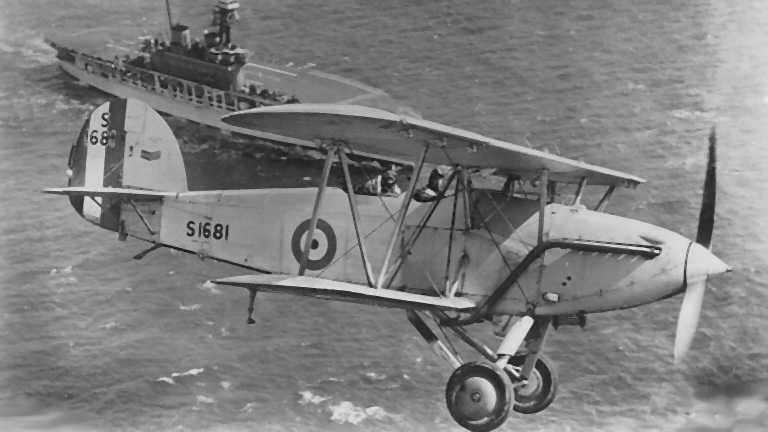
The Royal Navy found the Hawker Osprey an extremely useful aircraft. It was not much slower than the Nimrod single-seat fighter and could also be used for scouting, spotting and bombing .
The fighter/reconnaissance class of aircraft needed to be able to accommodate a second crew member to navigate the aircraft out to the enemy fleet and also to handle the radio equipment to report back by Morse code. The development of a radio homing beacon system¹ for getting back to the carrier meant that a more easily trained Telegraphist - Air Gunner (TAG) could be carried in the majority of the strike force of fighter/reconnaissance aircraft as long as they followed an aircraft crewed with an Observer (the Royal Navy's name for navigators) out to the target.
Of course, if the aircraft of the enemy fleet discovered the British fleet first, they could fly around it keeping out of range of the AA barrage. In this scenario, the fighter/reconnaissance aircraft could be launched to shoot down the shadowing aircraft, or at least ward it off. However, it was felt that turning an aircraft carrier into the wind to do this might still slow down the fleet and make it vulnerable at a critical time. So, it was envisioned that a version of the fighter/reconnaissance aircraft equipped with floats could be catapulted off one of the battleships or heavy cruisers of the fleet to deal with the enemy instead.

The fleet shadowing and spotter aircraft the Royal Navy feared more than enemy bombers. On top is the Italian Meridionali Ro 43. On the left is the Japanese Kawanishi E7K and on the right the German Heinkel He 60. If these aircraft could be shot down or driven off it was thought unlikely that enemy torpedo-bombers or dive bombers could find the fleet to launch an attack. If they did, then it was felt that AA fire was the best defence.
Once the two fleets closed for battle the TSR aircraft would be launched to carry out their role of spotting for the guns of the fleet (guiding them onto a target by reporting back by radio). The fighter/reconnaissance class would protect the spotting aircraft from any interference from enemy aircraft and also shoot down any enemy spotting aircraft.
That was the grand plan. Into the mix was thrown the Navy's growing appreciation for the possibilities of dive bombing, as developed by the Americans with their "Helldiver" aircraft. This held out the promise of making the attack on the flight deck of enemy carriers much more accurate. So, when the Navy drew up its plans for a replacement for the Hawker Osprey, it specified that the aircraft should be able to deliver a 500 lb (227 kg) bomb by dive bombing. The specification was issued in 1934 (Air Ministry specification O.27/34 to meet Operation Requirement OR15) and led to the Blackburn Skua. The requirement to have floats fitted was omitted from the specification and the Blackburn Skua never flew with floats.
The Royal Navy then decided a different type of aircraft was required to do the role of shooting down enemy spotters and fleet shadowing aircraft. It was also required to be able to spot for the guns of the fleet itself. The following year specification O30/35 was released, this time calling for a two-seat fighter/spotter that could be used from a carrier but also fitted with floats to be catapulted off capital ships. The specification had originally called for two forward-firing machine guns for the pilot and another two for the Observer/TAG in the back seat. A number of companies produced design studies but the Navy and Air Ministry seem to have been very impressed by Boulton Paul's P85 concept which concentrated the armament into one of their "A" type turrets with 4 machine guns. The P85 might have been a very potent aircraft if it had got into service, with a powerful Hercules engine and space for a third crew member². But the Hercules was in the early stages of development and the Navy couldn't wait. So the easy option was to fit the Boulton Paul turret into a modified version of the Skua. After considerable unforeseen delays caused by production bottlenecks, this ended up producing the Blackburn Roc.
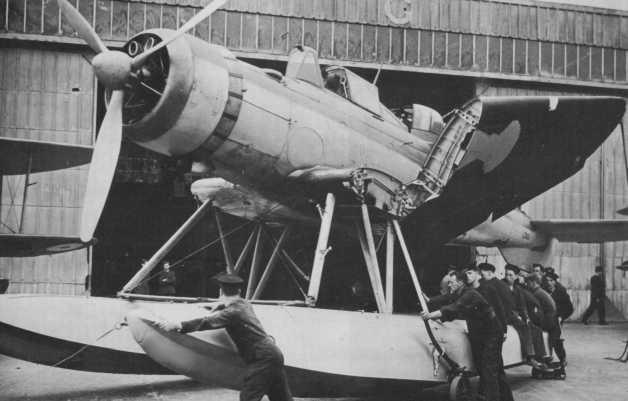
The Blackburn Roc on floats. In many books and articles on the Roc, the use of floats is presented as an afterthought; yet it was essential to the initial doctrine of having a catapult-launched spotter aircraft that could defend itself and also attack enemy spotters, as well as drive off enemy fleet-shadowing aircraft.
While all this had been going on, the political and strategic climate went through some dramatic changes. At the start of the 1930s, the Royal Navy had seen its chief opponent as being the Japanese in the Far East (although some colonial dispute with either the French or Americans could not be ruled out). It was for a full battlefleet engagement with the Japanese in mid-ocean that the Navy drew up their plans. Then in 1935, the Abyssinia crisis raised the spectre of war with Italy in the Mediterranian and Red Seas. This forced a reappraisal of the defence of the fleet against land-based bombers. From then on the growing threat from Germany made the Royal Navy concentrate more on the threat to trade across the Atlantic from German commerce raiders (it thought the submarine threat could be easily countered by ASDIC) and how to blockade Germany in turn. Also, the development of radar opened up the possibility of giving much more warning of the approach of enemy aircraft, enabling enough time for carriers to be turned and launch fighters to intercept them. In 1938, thirty-eight RAF Gloster Gladiators were fitted with arrestor hooks and transferred to the Royal Navy, this was followed by 60 more specially produced as "Sea Gladiators" with arrestor hooks, dinghy stowage and catapult gear. It seems this was not a change in doctrine by the Royal Navy, but simply because the delivery of both Skuas and Rocs was well behind schedule and the Navy desperately needed something to replace their ageing Ospreys and Nimrods, so the Gladiators were acquired as a stop-gap. Even as the first production Skuas were delivered a new aircraft to replace them was already being sought, the Fairey Fulmar, this kept the role of fighter/reconnaissance but dropped the ability to do dive bombing. Instead, the dive-bombing role was switched to the Fairey Albacore, which was also a torpedo bomber and was scheduled to replace the Fairey Swordfish. In turn, the successor to the Albacore, the Fairey Barracuda, was already on the drawing board.
Throughout the mid to late 1930s, the Royal Navy scrambled to equip its ships with new anti-aircraft weapons and converted a lot of their "C" class light cruisers to a dedicated anti-aircraft role. These had high-angle 4-inch guns for use against high-flying bombers and "2 pounder" pom-pom guns and large calibre water-cooled Vickers machine guns for use at closer ranges. They also commissioned a new class of dedicated anti-aircraft cruiser, the "Dido" class, that had no less than ten high-angle 5.25-inch guns for long-range anti-aircraft fire and the same mix of pom-poms and Vickers machine guns for shorter ranges.
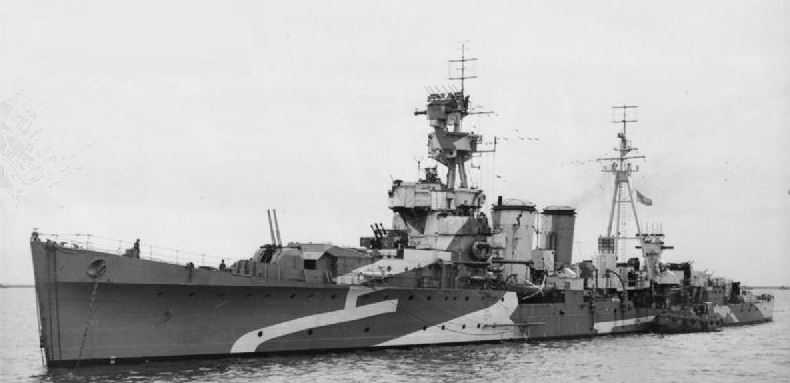
HMS Carlisle, one of the "C" class cruisers converted to the anti-aircraft role.
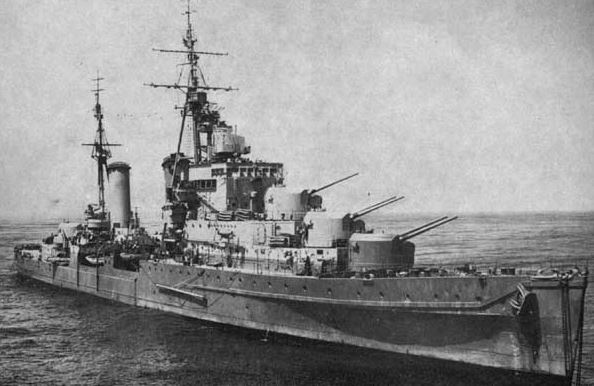
HMS Euryalus was one of the purpose-built "Dido" class of anti-aircraft cruisers. They were initially built with five large turrets (three forward, two aft) that each mounted two 5.25-inch dual-purpose guns. For shorter-range defence, the ships had two quad 2pdr pom-pom mountings and two quad .50-inch machine gun mountings.

HMS Euryalus was one of the purpose-built "Dido" class of anti-aircraft cruisers. They were initially built with five large turrets (three forward, two aft) that each mounted two 5.25-inch dual-purpose guns. For shorter-range defence, the ships had two quad 2pdr pom-pom mountings and two quad .50-inch machine gun mountings.

A 2pdr pom-pom gun. This is a quad mounting. Impressive to see firing, they lacked the range and lethality of the 40 mm Bofors gun, although late in the war their stopping power at shorter ranges proved effective against Japanese kamikaze attacks.
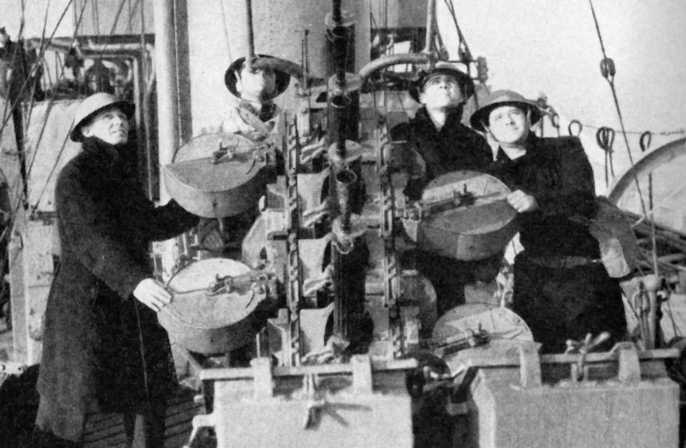
A quad Vickers .50-inch water-cooled machine gun. An unreliable and ineffective weapon, it did not have the range or stopping power of the contemporary American Browning .50 calibre machine gun. Its place on Royal Navy ships was usually taken by Oerlikon 20mm cannons.
At the outbreak of war, the policy of the fleet being protected from air attack by anti-aircraft fire alone was still in force. This was reflected by the fact that the first radar sets delivered to the Navy (Type 79) were fitted to battleships and anti-aircraft cruisers, rather than aircraft carriers. During the British fleet's first major wartime foray into the North Sea, Skuas were used to shoot down and ward off shadowing German seaplanes but were not launched when German bombers attacked (see this web page for a description of the events). The actions off Norway showed the folly of this policy. Anti-aircraft fire was nowhere near as effective as hoped in bringing down or deterring German bombers, while the dive-bombing attacks of the Germans proved more deadly than the Navy had expected. The stop-gap Sea Gladiators proved a godsend in defending the fleet while freeing up the longer-range Skuas for more offensive action. A few Rocs were used from carriers off Norway and they did ward off German recce aircraft on a couple of occasions but it was evident they were much too slow to overtake their prey (you can read a more detailed article about the use of the Skua and Roc in the Norwegian campaign at <this link>).
The high-angle heavy guns on British anti-aircraft cruisers were excellent weapons, but the systems to get them on target were found to be inadequate for the job. This did improve throughout the war with advancements in radar targeting, improved gyro stabilisation and proximity fuses. The 2-pounder pom-pom was found to be disappointing in service. Its shells would "auto-destruct" and explode at about 3,500 yards (3,200 metres), producing a "curtain" barrage³ but within that range, a shell would have to actually hit a target aircraft to explode and the chances of that were extremely small. A shortage of tracer shells for the pom-poms early in the war meant they didn't even have much of a deterrence effect against enemy bombers who were sometimes oblivious to the fact they were being fired at. It was found that the exploding shells of the 40mm Bofors gun were much more lethal and they had a higher deterrence effect, so pom-poms were replaced by Bofors guns from 1941 onwards. Pom-pom guns did make a comeback with the British fleet in the Pacific in 1945 where it was found that their stopping power against Kamikaze aircraft at very close ranges was effective. The Vickers .50-inch machine guns were another big disappointment, proving to be very unreliable and having poor range and destructive effects because of their low-velocity rounds. They were replaced by 20 mm Oerlikon cannons from 1941 onwards.
For all that, the anti-aircraft cruisers did prove a very welcome addition to the fleet, particularly after upgrading with Bofors guns and Oerlikon cannons. The last one to be launched, HMS Diadem, was not completed until January 1944. You have to wonder what might have happened if a couple of them had been with HMS Prince of Wales and HMS Repulse in December 1941 (many pundits speculate what might have happened if the carrier HMS Indomitable had been with them but ignore the navy's previous preferred anti-aircraft defence). The sinking of the Prince of Wales and Repulse showed up the problems with the policy of keeping radio silence. A Walrus seaplane launched from Repulse for an anti-submarine patrol had investigated a small commercial steamer, because of the radio silence rule the Walrus had to fly back to report its investigation by Aldis signal lamp. The Walrus was spotted by a Japanese reconnaissance aircraft which followed it back to the British ships and then homed the Japanese bomber force onto them. Radio silence also stopped the British ships from calling for fighter cover from the Malaysian mainland until it was too late.⁴
American wartime light cruisers of the Atlanta and Cleveland classes shared many of the attributes of the British anti-aircraft cruisers, with multiple high-angle dual-purpose guns. One authoritative German book on light-cruisers⁵ laments that the Königsberg class were not converted to the anti-aircraft role before the war to escort the battleships Bismark and Tirpitz.
The high-angle heavy guns on British anti-aircraft cruisers were excellent weapons, but the systems to get them on target were found to be inadequate for the job. This did improve throughout the war with advancements in radar targeting, improved gyro stabilisation and proximity fuses. The 2-pounder pom-pom was found to be disappointing in service. Its shells would "auto-destruct" and explode at about 3,500 yards (3,200 metres), producing a "curtain" barrage³ but within that range, a shell would have to actually hit a target aircraft to explode and the chances of that were extremely small. A shortage of tracer shells for the pom-poms early in the war meant they didn't even have much of a deterrence effect against enemy bombers who were sometimes oblivious to the fact they were being fired at. It was found that the exploding shells of the 40mm Bofors gun were much more lethal and they had a higher deterrence effect, so pom-poms were replaced by Bofors guns from 1941 onwards. Pom-pom guns did make a comeback with the British fleet in the Pacific in 1945 where it was found that their stopping power against Kamikaze aircraft at very close ranges was effective. The Vickers .50-inch machine guns were another big disappointment, proving to be very unreliable and having poor range and destructive effects because of their low-velocity rounds. They were replaced by 20 mm Oerlikon cannons from 1941 onwards.
For all that, the anti-aircraft cruisers did prove a very welcome addition to the fleet, particularly after upgrading with Bofors guns and Oerlikon cannons. The last one to be launched, HMS Diadem, was not completed until January 1944. You have to wonder what might have happened if a couple of them had been with HMS Prince of Wales and HMS Repulse in December 1941 (many pundits speculate what might have happened if the carrier HMS Indomitable had been with them but ignore the navy's previous preferred anti-aircraft defence). The sinking of the Prince of Wales and Repulse showed up the problems with the policy of keeping radio silence. A Walrus seaplane launched from Repulse for an anti-submarine patrol had investigated a small commercial steamer, because of the radio silence rule the Walrus had to fly back to report its investigation by Aldis signal lamp. The Walrus was spotted by a Japanese reconnaissance aircraft which followed it back to the British ships and then homed the Japanese bomber force onto them. Radio silence also stopped the British ships from calling for fighter cover from the Malaysian mainland until it was too late.⁴
American wartime light cruisers of the Atlanta and Cleveland classes shared many of the attributes of the British anti-aircraft cruisers, with multiple high-angle dual-purpose guns. One authoritative German book on light-cruisers⁵ laments that the Königsberg class were not converted to the anti-aircraft role before the war to escort the battleships Bismark and Tirpitz.

Skua taking off from aircraft carrier.
There are two paradigms for upgrading military equipment. One is to just replace equipment with something better, in the case of aircraft something faster, more reliable, with longer range, etc. The other is to rethink the issues involved and come up with different solutions, inventing new classes of weapons while usually dispensing with others completely. The Royal Navy believed it had come up with valid solutions to defeating air attacks on the fleet, and those solutions seemed to have been vindicated when they ran exercises to test them. Unfortunately, the Navy ran exercises against itself using the tactics it, itself, used, so it's no surprise that its methods seemed to work. It was trapped in a feedback loop of self-fulfilment until the start of war revealed the grim reality that other nations did things differently.
List of British light cruisers converted to the anti-aircraft role.
Caledon, Coventry, Curlew, Curacoa, Cairo, Calcutta, Carlisle, Colombo.
List of British light cruisers built for the anti-aircraft role.
Bonaventure, Naiad, Phoebe, Dido, Euryalus, Hermione, Sirius, Cleopatra, Charybdis, Scylla, Argonaught, Spartan, Bellona, Black Prince, Royalist, Diadem.
NOTES
¹ The British Type 72 homing beacon was designed to make it difficult for the enemy to use to find the fleet, giving out "blips" too short for a direction-finding (DF) loop to align with. Even so, the Navy's obsession with radio silence meant the beacon would only be switched on briefly at pre-arranged times. A lost aircraft could use Morse code to request the beacon be switched on, but only by passing a time-sensitive codeword.
² For details of the P85 see "Boulton Paul 1917-1961- Aircraft, Projects and Studies" by Les Whitehouse, published by Crecy in 2021, ISBN 9781910809488
³ The 2-pounder pom-pom had been originally designed so that the shell could be fused to explode at varying distances. However, this method was dropped between the wars after trials showed that crews had difficulty judging the distance to targets. The deterrent effect of placing a barrage of explosions in front of an attacking aircraft was not appreciated. The ammunition provided during WW2 only had the one fuse setting. It seems that some of the older pom-pom mountings retained the mechanism for setting the shell to explode at different distances, but this was of no use with the ammunition provided.
⁴ See chapter 3 of "Bloody Shambles - Volume 1" by Brian Cull and Yasuho Izawa. It covers the aerial aspects of the sinkings in great detail. Grub Street Press 1992. ISBN 0 948817 50 X.
⁵ "German Light Cruisers of World War Two" by Gerhard Koop and Klaus-Peter Schmolke ISBN 1-85367-485-0.
LINKS
Armoured Carriers YouTube video on 2 pdr Pom Pom guns
The 2pdr Pom Pom on the NavWeapons website
The Vickers .50" machine gun on the NavWeapons website
Bofors Gun on the NavWeapons website
20mm Oerlikon on the NavWeapons website
Type 79 Radar
SOURCES AND FURTHER READING
Fighters Over the Fleet: Naval Air Defence from Biplanes to the Cold War: By Norman Friedman, published in 2016 by the Naval Institute Press. ISBN-10 : 159114616X. ISBN-13 : 978-1591146162. This is an excellent book which puts right many of the mistaken ideas about the doctrine behind the Skua and Roc designs. Chapter 3, "Fighters without Radar" is essential reading for anyone wanting to understand the concepts that governed their designs.
Naval Anti-Aircraft Guns & Gunnery: By Norman Friedman, published in 2014 by Seaforth Publishing. ISBN 10: 1848321775. ISBN 13: 9781848321779. This goes into great detail about the anti-aircraft weapons used by the Royal Navy.
Air Power and the Royal Navy - 1914-1945 - A Historical Survey: By Geoffrey Till. Published by Jane's Publishing company in 1979. ISBN 0 354 01204 5.
A full bibliography of books about the Blackburn Skua and Roc can be found at <this web page>.
